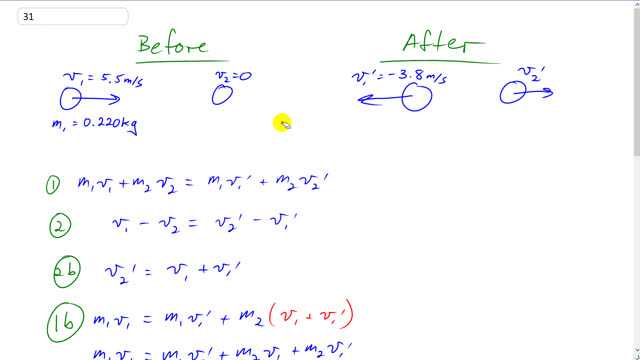
A ball of mass 0.220 kg that is moving with a speed of 5.5 m/s collides head-on and elastically with another ball initially at rest. Immediately after the collision, the incoming ball bounces backward with a speed of 3.8 m/s. Calculate
- the velocity of the target ball after the collision, and
- the mass of the target ball.

In order to watch this solution you need to have a subscription.
This is Giancoli Answers with Mr. Dychko. Before the collision, we have ball one approaching at 5.50 meters per second, that's a mass of 0.220 kilograms and ball two is initially at rest and we don't know what the mass of it is. And after the collision, ball one rebounds which means that its velocity will be in the opposite direction to its original velocity so the word 'rebounds' indicates a negative here for its velocity after the collision. So v 1 prime is negative 3.80 meters per second and v 2 prime is something to the right. So our job is to figure out what v 2 prime is and figure out the mass of ball two. Now because of conservation of momentum, we know this and because the collision is elastic, we know this as well and we'll work with equation 2 a little bit to figure out what v 2 prime is and then we'll substitute into equation 1 and replace v 2 prime with v 1 plus v 1 prime in order to reduce the number of unknown's in equation 1 so that the only thing we don't know is m 2 and then we can solve for it. So v 2 is zero so both these terms disappear because the ball two is initially at rest and so that means this conservation of energy formula turns into v 2 prime is v 1 plus v 1 prime because I moved this term to the left side by adding it to both sides and then switch the sides around so we have v 2 prime is v 1 plus v 1 prime. So we are rewriting equation 1 with that substitution for v 2 prime as v 1 plus v 1 prime here gives us m 1v 1 equals m 1v 1 prime plus m 2 times v 1 plus v 1 prime and then distribute the m 2 into the bracket there multiply the v 1 by m 2 and multiply the v 1 prime by m 2 and we get this line and then we are solving for m 2 here; I'm answering part (b) of the question first just because that's how my thought process worked out here, I could have answered part (a) here by the way just by substituting into there but anyway so we are gonna solve for m 2 here. And factor that common factor out of these two terms and we have m 2 multiplied by v 1 plus v 1 prime and that's what I have written here and then move this term to the left side which makes the v 1 prime term negative by subtracting it from both sides and then it has a common factor m 1 which we can factor out. So we have m 1 times v 1 minus v 1 prime and then I have switched the sides around as well so we have the unknown m 2 on the left and then divide both sides by v 1 plus v 1 prime and we get the m 2 is m 1 times v 1 minus v 1 prime divided by v 1 plus v 1 prime. So that's 0.220 kilograms times 5.50 meters per second minus negative 3.8 meters per second— careful with your negatives there— and divided by 5.50 plus negative 3.80. So we end up with 1.2 kilograms is the mass of ball two. And the velocity of ball two, we know, is v 1 plus v 1 prime after we rearrange this conservation of energy formula and so we'll substitute in these known velocities. So initially the ball one has a velocity of 5.50 meters per second and then after collision has a velocity of plus negative 3.80 meters per second and we end up with 1.70 meters per second is the velocity of ball two after the collision.